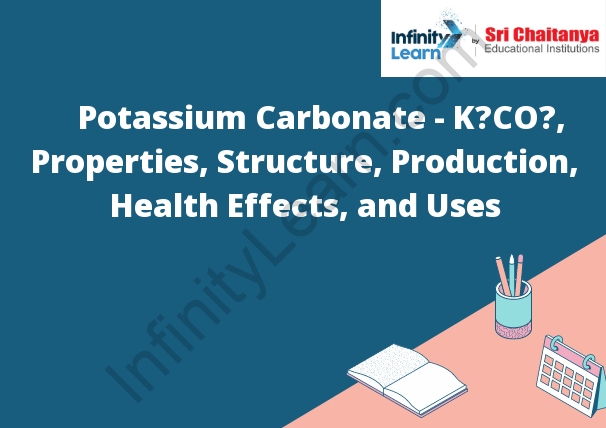Table of Contents
What is Potassium Carbonate?
Potassium carbonate is a salt that is made up of potassium, carbon and oxygen. It is a white solid that is soluble in water. Potassium carbonate used in a variety of industries including the chemical, plastic, and textile industries. It also used in the production of soaps and detergents. Potassium carbonate also used as a food additive to improve the flavor of food.

Properties of Potassium Carbonate – K₂CO₃
Potassium carbonate is a white, odorless, and slightly soluble salt. It is a weak base and can be used to neutralize acids. It also used in the production of glass, soap, and fireworks.
Potassium Carbonate Structure – K₂CO₃
- Potassium carbonate is a white, odorless, slightly soluble solid. It is a basic carbonate with the formula K2CO3. However it can made by reacting potassium hydroxide with carbon dioxide, or by the thermal decomposition of potassium hydrogen carbonate.
- Potassium carbonate used in the production of soap, glass, and pottery. It also used in the textile industry as a fabric softener.
Production of Potassium Carbonate
- The production of potassium carbonate is a two-step process. The first step is the production of potassium chloride, which then reacted with carbon dioxide to produce potassium carbonate.
- Potassium chloride produced by the electrolysis of potassium hydroxide. Potassium hydroxide also produced by the electrolysis of potassium chloride.
- It electrolyzed to produce potassium and chlorine gas.
- Potassium carbonate produced by the reaction of potassium chloride and carbon dioxide.
Uses of Potassium Carbonate
- There are a variety of uses for potassium carbonate.
- It can also used as a food additive, a flame retardant, a textile printing agent, a water softener, and a variety of other industrial applications.
Potential Health Effects
Inhalation:
May cause respiratory tract irritation.
Ingestion:
May cause gastrointestinal tract irritation.
Skin Contact:
May cause skin irritation.
Eye Contact:
May cause eye irritation.
Applications Potassium Carbonate
- Potassium carbonate is a white solid that is soluble in water. It produced commercially by the Solvay process, which involves the electrolysis of a potassium chloride (KCl) solution.
- Potassium carbonate used in the production of glass, soap, and aluminum. It also used as a flux in the smelting of copper and other metals.
Potassium Carbonate’s Food Safety
Potassium carbonate is a food additive that generally recognized as safe by the U.S. Food and Drug Administration. It used as a leavening agent in baked goods and as a firming agent in canned fruits and vegetables. It also used in some chewing gums. In small amounts, potassium carbonate is safe for human consumption.








